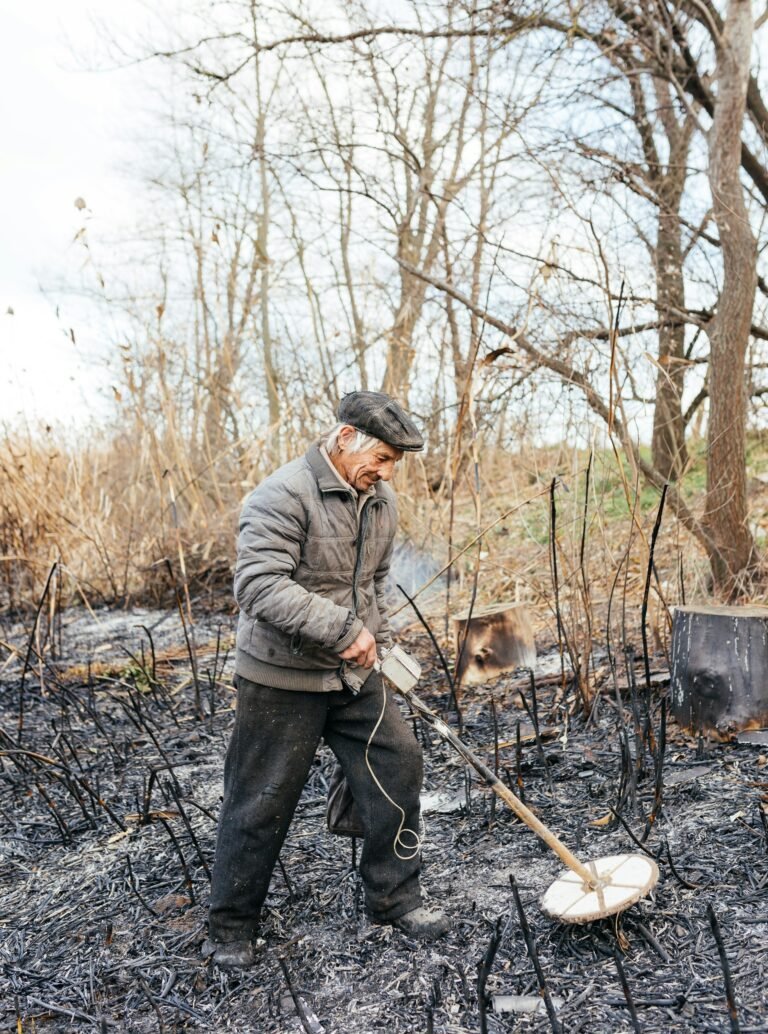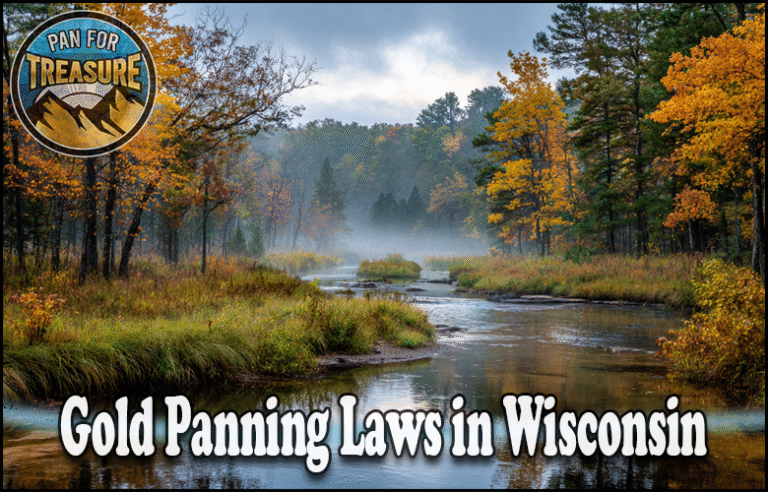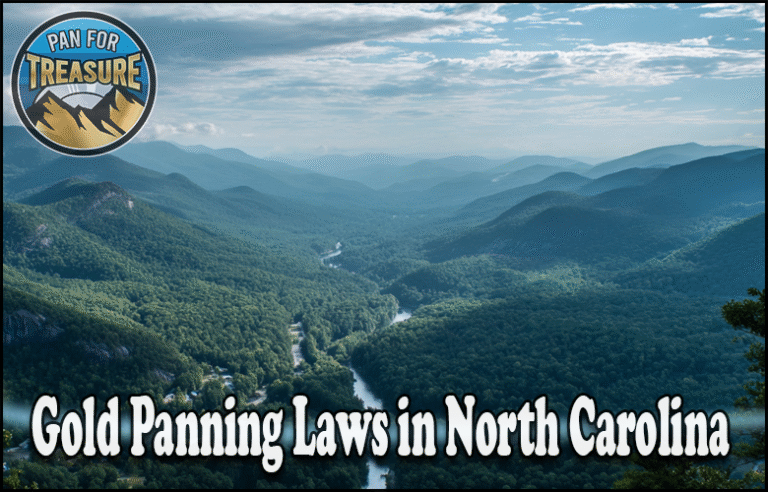
Disclosure: This Post Contains Affiliate Links; We earn a commission on purchases.
California has a rich history of gold panning, attracting prospectors from all over the world.
However, it’s crucial to understand the laws and regulations surrounding this activity to ensure a safe and legal experience.
Whether you are a seasoned prospector or a beginner, familiarizing yourself with the regulations is essential to avoid potential penalties and conflicts.
Regulations for gold panning in California vary depending on the location and the type of land you plan to explore.
Public lands managed by the Bureau of Land Management are generally open for recreational gold panning, but there may be restrictions in certain areas.
It’s important to check with the local authorities or landowners to determine any specific guidelines or limitations.
Furthermore, the California Department of Fish and Wildlife requires a free permit for recreational mining on public lands.
This permit ensures that prospectors abide by environmental regulations and helps protect the state’s natural resources.
Additionally, there are restrictions on mining near occupied dwellings and the use of motorized equipment, such as dredges or highbankers, which may require a special permit.
By understanding and following the gold panning laws in California, prospectors can enjoy their activities while preserving the environment and maintaining a respectful relationship with landowners and authorities.
Key Takeaways:
- Gold panning laws in California are important to ensure a safe and legal experience.
- Public lands managed by the Bureau of Land Management are generally open for recreational gold panning, but there may be restrictions.
- A free permit from the California Department of Fish and Wildlife is required for recreational mining on public lands.
- There are limitations on mining near occupied dwellings and the use of motorized equipment.
- Understanding and adhering to the regulations helps preserve California’s natural resources and maintain a respectful relationship with landowners and authorities.
The Gold Rush and California’s Mining History
California’s gold rush history dates back to 1848 when gold was discovered at Sutter’s Mill. This historic event sparked a frenzy of people from all over the world flocking to California in search of fortune. The gold rush had a transformative impact on California’s population, economy, and landscape.
Thousands of prospectors, known as “forty-niners,” arrived in California with dreams of striking it rich. The influx of people contributed to the rapid growth and development of cities, such as San Francisco, and led to the establishment of new towns and communities throughout the state.
The gold rush also brought about significant changes in the mining industry. Hydraulic mining, a technique that used high-pressure water jets to wash away hillsides in search of gold deposits, became widely utilized during this time. While it allowed for efficient gold recovery, hydraulic mining had severe environmental consequences.
“The gold rush created a surge of hydraulic mining activities in California, with devastating effects on the environment.”
The extensive use of water cannons for hydraulic mining resulted in the erosion of hillsides and the release of sediment into rivers and streams. This sedimentation hindered aquatic ecosystems, damaging fish habitats and disrupting the balance of natural ecosystems.
Additionally, miners used mercury to separate gold particles from sediments. The mercury inevitably found its way into water sources, posing a threat to both human health and the environment.
Understanding the history of the gold rush and its impact on California is crucial for modern-day prospectors. It highlights the importance of responsible mining practices and the need to balance economic pursuits with environmental conservation.
Furthermore, the gold rush played a significant role in shaping California’s identity and culture. It fostered diversity and multiculturalism as people from various backgrounds came together in pursuit of a common goal. The legacy of the gold rush can still be seen today in the state’s vibrant communities and rich historical landmarks.
Related Gold Panning Information
Know the Regulations Before You Pan
Before engaging in gold panning in California, it’s crucial to be aware of the state’s laws and regulations. The California Department of Fish and Wildlife is responsible for overseeing and implementing these regulations to protect the environment and ensure the responsible practice of recreational mining.
Individuals interested in recreational mining on public lands must obtain a permit issued by the California Department of Fish and Wildlife. The good news is that this permit is free of charge, making it accessible to all who wish to participate in this activity.
There are certain restrictions in place to safeguard the well-being of both miners and the environment. For instance, mining within 100 yards of occupied dwellings is prohibited without written consent from the owner. This measure helps protect the privacy and tranquility of residents.
Additionally, the use of motorized equipment such as dredges or highbankers requires a special permit. This is because motorized equipment can have a disruptive impact on the surrounding nature and wildlife if not regulated properly.
It’s important to note that in an effort to preserve water quality and protect fish habitats, there is currently a suction dredging ban in place in most areas of California. Suction dredging involves using machines to suck up gravel from riverbeds and extract valuable minerals like gold. While this technique may be effective for prospecting, it can also have detrimental effects on the environment if not carefully managed.
“The regulations put in place by the California Department of Fish and Wildlife serve an important purpose. They ensure that recreational mining can coexist with the preservation of the state’s natural resources and ecological balance. By adhering to these rules, miners can contribute to the sustainable development of gold panning activities in California.”
Exploring Public and Private Gold Panning Areas
California offers a diverse range of gold panning opportunities, both on public and private lands. Understanding the distinctions and permissions involved can help prospectors make the most of their gold panning experiences.
Public Gold Panning Areas in California
Public lands managed by the Bureau of Land Management (BLM) and national forests allow for recreational gold panning with the necessary permits. These areas provide access to rivers and streams known for their gold deposits. However, it’s essential to be aware of any restrictions or closures in specific locations due to environmental concerns or cultural significance.
To ensure a successful and compliant gold panning experience, prospectors should research and obtain the appropriate permits and adhere to any guidelines or restrictions set forth by the managing authorities.
Private Gold Panning Areas in California
Private properties in California require permission from the landowners or claim holders before engaging in any gold panning activities. It’s crucial to respect the rights of private landowners and obtain proper authorization before entering their lands.
Some mining companies offer opportunities for tours or hands-on mining experiences on their claims, providing prospectors with unique access to private gold panning areas. These experiences often come with expert guidance and valuable insights into the art of gold prospecting.
By exploring both public and private gold panning areas, prospectors can expand their options and increase their chances of finding valuable gold deposits.
Rivers and Streams for Gold Panning in California
California’s rivers and streams are renowned for their gold-bearing potential. Here are some notable waterways where prospectors can try their luck:
| River/Stream | Location |
|---|---|
| American River | Coloma |
| Klamath River | Humboldt County |
| Trinity River | Trinity County |
| Feather River | Butte County |
| Mokelumne River | Calaveras County |
These rivers and streams are just a few examples of the many gold-bearing waterways you can explore in California. Remember to follow all applicable regulations and obtain the necessary permits before engaging in any gold panning activities.
For a visual representation of gold panning areas in California, refer to the image below:
Methods of Gold Prospecting in California
When it comes to gold prospecting in California, there are several methods that you can employ to increase your chances of finding that elusive treasure. Each method has its own unique advantages and disadvantages, allowing prospectors to choose the approach that best suits their preferences and situation.
Hand Panning for Gold in California
Hand panning is a traditional and low-tech method of gold prospecting that requires only a pan and your own hands. With this method, you carefully sift through gravel and sediment in search of gold particles. Hand panning allows for close examination of every scoop, making it ideal for beginners and those who enjoy the hands-on experience of connecting with nature.
Sluicing for Gold in California
Sluicing involves using water to wash away dirt and debris while leaving behind heavier materials, such as gold. This method utilizes a sluice box, which is a long trough with riffles. As water flows through the sluice box, the riffles catch the heavier gold particles, allowing you to collect them. Sluicing is a more efficient method compared to hand panning, as it processes larger volumes of material.
Dredging for Gold in California
Dredging is a mechanized method that utilizes machines to suck up gravel from riverbeds and sort out precious metals, including gold. This method is especially effective when dealing with larger volumes of material, allowing for the processing of a significant amount of material in a shorter period of time. However, please note that dredging may have specific regulations and restrictions in certain areas.
Metal Detecting for Gold in California
Metal detecting is a popular method for locating small pieces of gold that may be hidden underground. By using a metal detector, prospectors can scan the ground and listen for signals indicating the presence of metal. Metal detecting is particularly useful in areas where gold particles are present but not easily visible, allowing you to cover a larger area in search of hidden treasures.
A Comparison of Gold Prospecting Methods
| Method | Advantages | Disadvantages |
|---|---|---|
| Hand Panning | Accessible for beginners, close examination of material | Slow process, limited processing capacity |
| Sluicing | Higher processing capacity, efficient recovery | Requires water source, larger equipment |
| Dredging | Highly efficient, processes large volumes of material | Regulated in some areas, requires specialized equipment |
| Metal Detecting | Covers larger area, effective for hidden gold | Relies on signals, limited to areas with metal presence |
Each gold prospecting method has its own unique appeal and can yield successful results depending on various factors such as location, experience level, and personal preference. Consider experimenting with different methods to find the one that best suits your needs and maximizes your chances of striking gold in the beautiful California landscape.
Tips for Successful Gold Panning
Successful gold panning in California requires the proper technique to increase your chances of finding gold. Follow these tips to enhance your gold panning experience:
- Choose the Right Location: Find a spot along a creek or river where gold deposits are likely. Research historical mining areas and look for signs of previous gold discoveries.
- Don’t Overload Your Pan: Avoid adding too much material to your pan as it can make it difficult to effectively separate the gold from the sediment. Start with a small amount and gradually add more if necessary.
- Gently Shake the Pan: Shake the pan from side to side in a gentle motion to allow the lighter materials to wash away. Avoid aggressive shaking, as it can cause the gold to be lost.
- Tilt the Pan: Tilt the pan forward, allowing the water to flow over the edge. This action helps to wash away the lighter materials, leaving behind the heavier black sand that may contain gold.
- Continuously Repeat the Process: Empty out the unwanted materials and continue shaking and tilting the pan until only the black sand remains. Be patient and thorough in your panning technique.
To extract visible flakes or nuggets, you can use tweezers or a snuffer bottle. These tools allow for precise extraction without losing any valuable gold. Remember, extracting gold from sediment requires careful attention to detail and patience.
“Proper technique and attention to detail are key factors for successful gold panning.”
| Tip | Key Points |
|---|---|
| Choose the Right Location | Research historical mining areas Look for signs of previous gold discoveries |
| Don’t Overload Your Pan | Start with a small amount of material Avoid adding too much at once |
| Gently Shake the Pan | Use a gentle side-to-side motion Avoid aggressive shaking |
| Tilt the Pan | Allow water to flow over the edge Wash away lighter materials |
| Continuously Repeat the Process | Empty unwanted materials Continue shaking and tilting |
Top Gold Panning Spots in California
California offers numerous top spots for gold panning. From historic sites to picturesque rivers, here are some notable locations:
Marshall Gold Discovery State Historic Park
Located in Coloma, Marshall Gold Discovery State Historic Park allows visitors to pan for gold nuggets along the creek bed. This park holds immense historical significance as it is where the California Gold Rush began in 1848. In addition to gold panning, the park offers informative demonstrations and exhibits, allowing visitors to immerse themselves in the rich history of the area.
Butte County Gold Panning Spot
Butte County is another popular location for gold panning in California. With accessible areas and abundant gold deposits, prospectors have the opportunity to find their own treasures here. The county is known for its scenic landscapes and offers a great experience for both beginners and experienced gold panners.
South Yuba River Gold Panning
The South Yuba River State Park in Bridgeport provides a unique opportunity for gold panning using the “hands and pans” method. This method involves using a gold pan and your hands to separate gold from the sediment. The park’s beautiful river and tranquil surroundings make it a favorite spot for gold panners seeking a more immersive and hands-on experience.
Merced River Gold Panning
The Merced River, located in Yosemite Valley, is another notable gold panning spot in California. Visitors can enjoy the stunning natural beauty of the area while trying their luck at finding gold. The river’s clear waters and pristine surroundings create a peaceful environment for prospecting.
Columbia State Historic Park Gold Panning
For those interested in combining gold panning with a taste of the Old West, Columbia State Historic Park is the perfect destination. This living gold rush town in Tuolumne County offers guided tours, historical reenactments, and the opportunity to pan for gold just like the prospectors of the past. It’s a truly unique and immersive gold panning experience.
These top gold panning spots in California provide a variety of experiences for prospectors of all levels. Whether you’re interested in historical sites, picturesque rivers, or hands-on learning, there’s something for everyone in the Golden State.
Exploring California’s Mineral-Rich Sites
In addition to gold panning, California offers exciting opportunities for rockhounding and gathering other minerals. The state is known for its diverse geological formations and rich deposits, making it a treasure trove for rock enthusiasts and mineral collectors.
Rockhounding in California provides a unique opportunity to discover beautiful crystals, gemstones, and fascinating geological specimens. From sprawling beaches to rugged mountain ranges, the state offers a diverse range of environments to explore.
The California Department of Parks and Recreation permits rockhounding activities, which includes panning for gold in gravel beds of streams. However, it’s important to note that the use of tools other than gold pans is restricted in these areas.
There are specific restrictions on the gathering and commercial use of rocks and minerals in California. It’s crucial to be aware of the rules and regulations related to rockhounding to ensure a responsible and legal experience.
Different regions of California offer unique opportunities for rockhounding. Areas like beaches, wave action zones, and certain state parks are designated for rockhounding activities. These designated sites help protect delicate ecosystems and ensure the sustainability of the hobby.
If you’re interested in rockhounding in California, it’s recommended to research specific areas and familiarize yourself with any additional regulations or restrictions that may apply. Be respectful of the environment and leave no trace as you explore the state’s mineral-rich sites.
Whether you’re a beginner or an experienced rockhound, California’s vast landscapes are sure to offer exciting discoveries and memorable experiences.
Popular Mineral Gathering Areas in California
| Location | Minerals | Accessibility |
|---|---|---|
| Death Valley National Park | Borax, Halite, Quartz | Accessible by vehicle |
| Trona Pinnacles | Trona, Borax, Halite | Accessible by vehicle |
| Clear Creek Recreation Area | Agate, Jasper, Serpentine | Accessible by vehicle and hiking |
| Anza-Borrego Desert State Park | Feldspar, Agate, Calcite | Accessible by vehicle and hiking |
| Panamint Range | Olivine, Serpentine, Talc | Accessible by hiking |
Table: Popular Mineral Gathering Areas in California.
Joining Mining Clubs and Associations
Prospective gold panners in California can benefit greatly from joining mining clubs and associations. These groups provide a wealth of resources and opportunities to enhance your gold prospecting experience. Here are some key benefits of joining mining clubs in California:
1. Training Programs
Many mining clubs offer training programs that cater to both beginners and experienced prospectors. These programs provide valuable guidance on gold panning techniques, equipment usage, and safety measures. By participating in these training sessions, you can gain the necessary skills and knowledge to improve your success rate in finding gold.
2. Organized Outings and Group Events
Mining clubs often plan organized outings and group events for their members. These outings allow you to explore different gold panning locations in California alongside experienced prospectors. It’s a fantastic opportunity to learn from seasoned experts, exchange tips and tricks, and discover new productive spots.
3. Shared Knowledge and Resources
When you join a mining club, you become part of a community that shares a common passion for gold prospecting. This community is a valuable resource in itself, offering a wealth of knowledge and experiences. By interacting with other members, you can learn about new techniques, equipment recommendations, and even share information about potential gold-rich areas.
4. Access to Group-Owned Claims
Many mining clubs and associations have their own claims, which provide exclusive access to promising gold-bearing areas. By joining a club, you gain the opportunity to prospect in these private claims, increasing your chances of finding valuable gold deposits. This access to group-owned claims can be a major advantage for gold panners in California.
Joining a mining club or association is a surefire way to enhance your gold panning skills, expand your network within the prospecting community, and gain access to exclusive resources. Whether you’re a beginner or an experienced prospector, the benefits of joining mining clubs in California are undeniable.
| Club/Association Name | Location | Contact Information |
|---|---|---|
| California Gold Panning | Glenville, CA | www.californiagoldpanning.com |
| Gold Prospectors Association of America (GPAA) | Temecula, CA | www.goldprospectors.org |
| Central Valley Prospectors | Sacramento, CA | www.cvprospectors.org |
| The New 49ers | Happy Camp, CA | www.goldgold.com |
Conclusion
Gold panning in California is an exciting and rewarding activity that allows prospectors to experience the thrill of searching for gold in the Golden State. However, it is crucial to abide by the laws and regulations to ensure a safe and legal experience.
Prospectors should start by obtaining the necessary permits, such as the free permit from the California Department of Fish and Wildlife for recreational mining on public lands. Understanding the restrictions is also vital. For instance, mining within 100 yards of occupied dwellings requires written consent from the owner, and the use of motorized equipment may require a special permit.
Respecting the environment is equally important. Prospecting enthusiasts should research specific areas to ensure they are open for panning and follow proper techniques to minimize any negative impact. Additionally, joining mining clubs or associations can provide valuable resources, training programs, and opportunities to learn from experienced prospectors.
In summary, gold panning in California can be a fulfilling adventure when done responsibly. By following the laws, obtaining permits, preserving the environment, and staying informed, prospectors can enjoy the excitement of searching for gold while respecting California’s natural resources. So, grab your pan and get ready to discover the golden treasures that await you!
Source Links
- https://www.parks.ca.gov/?page_id=30708
- https://www.sunset.com/travel/where-to-pan-for-gold-in-california

Meet Ryan Conlon, the passionate owner and driving force behind Pan for Treasure.
With an unwavering love for the art of gold panning, Ryan has transformed his enthusiasm into a thriving community hub for fellow treasure seekers. info@panfortreasure.com
A seasoned gold panning enthusiast, Ryan’s journey began with a simple pan and a dream, evolving into a deep appreciation for the history, geology, and thrill of uncovering precious metals.
Subscribe to Our Newsletter






